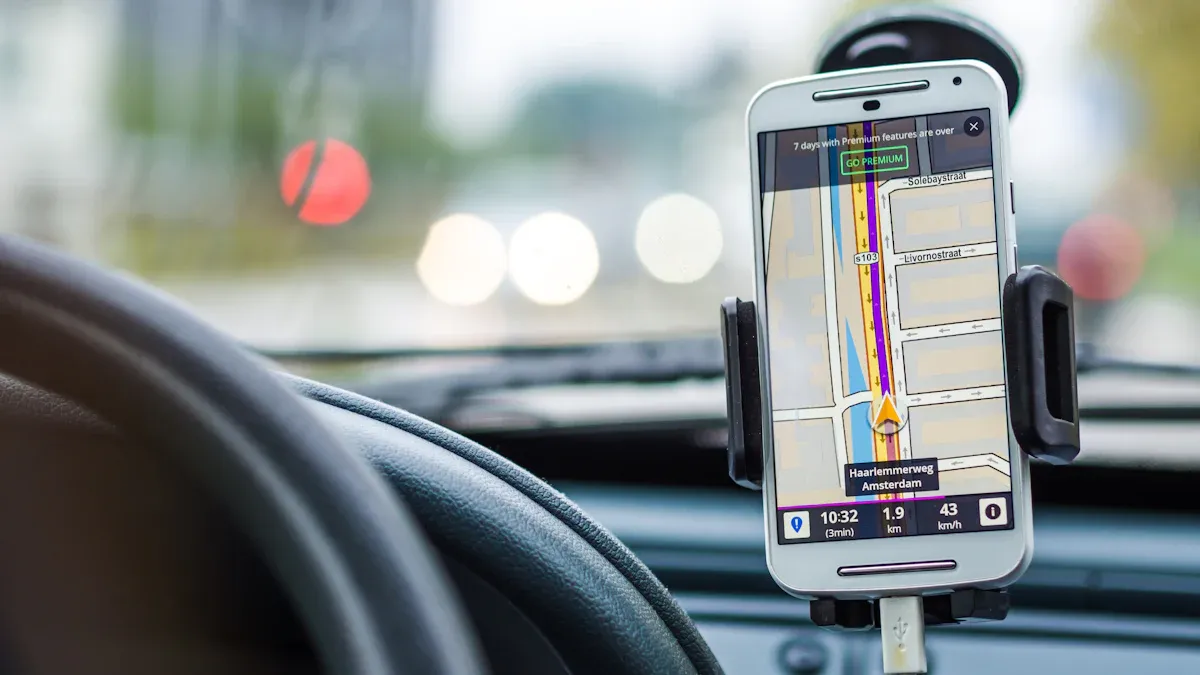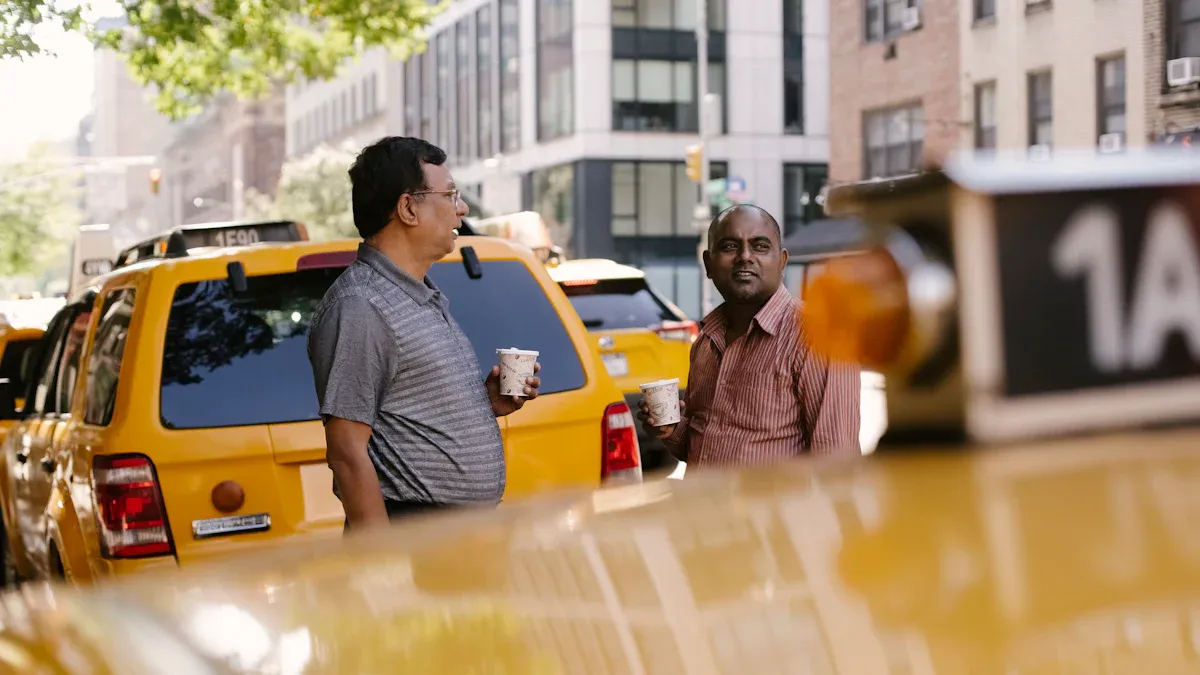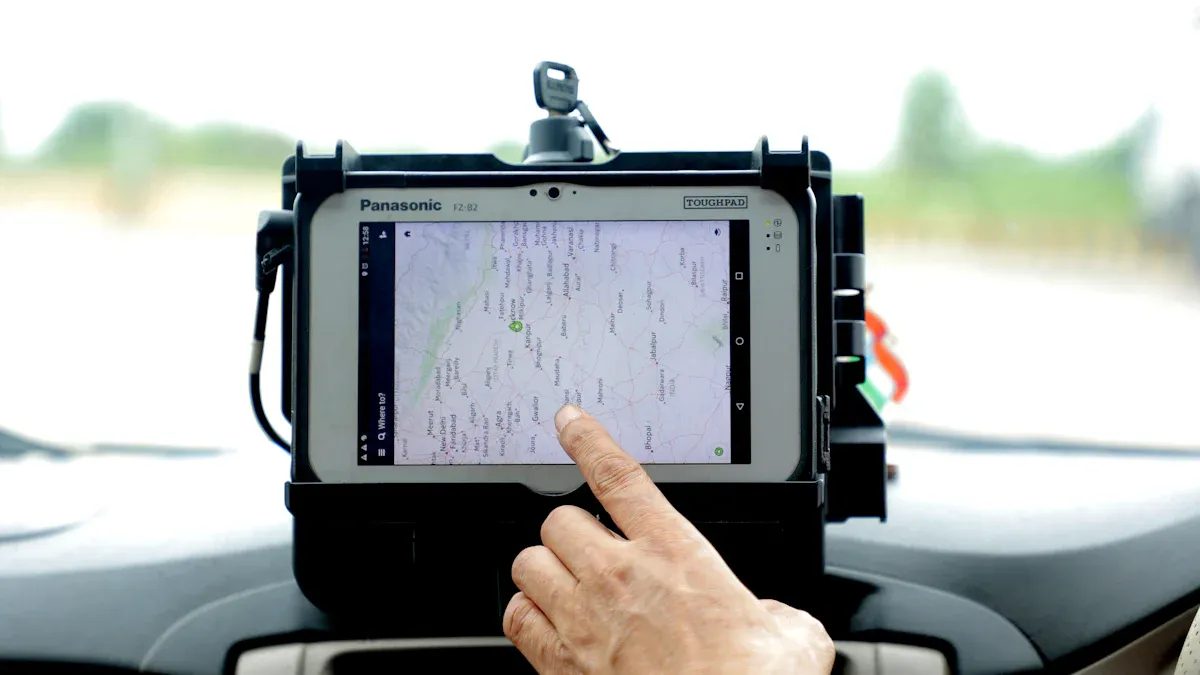
Taxi advertising is making a big impact in many cities. Studies show people remember ads on taxis longer than other outdoor ads. Brands choose taxi advertising because it reaches people everywhere. Taxis travel through neighborhoods where people live, work, and have fun, acting as moving billboards for brands and giving ads great visibility. The GPS-Based Taxi Advertising Screen with Location-Specific Playback takes this a step further by showing ads at the right place and time. This technology helps brands reach people at the best moment, maximizing the impact of their message. The strong effect of the GPS-Based Taxi Advertising Screen with Location-Specific Playback helps companies discover new ways to get noticed.
Key Takeaways
GPS-based taxi ads reach lots of people. They show the right message in the right place and at the right time. Brands can change ads fast. They can also see how well the ads work by using digital screens and real-time data. Good campaigns use bright and creative ads. These ads catch people’s eyes and connect with local people. Taxi ads cost less than big billboards. They still work well because taxis move through busy city areas. This smart advertising helps brands grow. It helps them talk to customers. It can also help make cities cleaner and greener.
Success of GPS-Based Taxi Advertising
High Recall and Brand Impact
Taxi cab advertising is easy to notice in cities. Brands get good results because these ads reach many people every day. Studies say people remember ads on moving cars more than on signs that do not move. When brands use fun pictures and messages, taxi cab ads work even better. Digital screens at taxi stops catch people’s eyes and help more people know about a brand. Riders and people walking by see these ads, especially if they are bright and colorful.
Studies show that out-of-home ads, like taxi cab ads, can make more people remember a brand by 3%, like a brand by 3.5%, and want to buy by 6.2%. These numbers show that taxi cab ads really help brands.
Many brands do well by using cool wraps, fun things to do, and social media. Spotify, Amazon Prime, and Pretty Little Things all used taxi cab ads to make people remember them and get excited. These stories show that taxi cab ads can make a normal ride special for brands.
Why Brands Choose This Campaign
Brands pick taxi cab ads because they are flexible and work well. Taxi cab ads go through busy streets and reach people in many places. This helps brands talk to people from different areas and even visitors. Taxi cab ads can also change messages using digital screens, so brands can show different ads in different places or times.
Taxi cab ads move all over the city and lots of people see them.
Bright and moving screens get attention all day and night.
Brands can change ads from far away and pick where to show them.
Taxi cab ads cost less than big billboards.
GPS helps brands show ads to certain groups or places.
Digital screens count how many people see the ads, so brands can make their ads better.
Taxi cab ads reach many people every day and brands can see how well they do. Brands get good results because they can count views and change ads to do better. Taxi cab ads work better than many other city ads, so brands like to use them to get more people interested and make their campaigns win.
Successful Taxi Cab Advertising Campaigns
Spotify’s Creative Approach
Spotify wanted to reach music fans in busy cities. They put bright and creative ads on taxis. There were many other ads in these places. Spotify used GPS screens to show ads where people listened to music most. This made each taxi ride feel special for riders.
Spotify’s taxi ads helped the brand reach more people. The campaign made app downloads go up by 24% in those areas. More people visited Spotify’s website in those places too. Spotify asked users to share their music stats online. This made even more people talk about Spotify. The campaign showed that taxi ads can make a normal ride exciting for a brand.
Spotify turned taxis into moving billboards.
GPS screens showed ads in the best neighborhoods.
The campaign made more people download the app and visit the website.
More people shared Spotify content online.
Coca-Cola and Air Asia Campaigns
Coca-Cola and Air Asia wanted to reach busy city crowds. Both brands had to get noticed among many other ads. They used taxi ads to help their brands stand out. Coca-Cola wrapped taxis in its famous red color and logo. Air Asia put digital screens on taxis to show flight deals and travel tips.
Both brands used GPS tech to show ads in busy places. Coca-Cola focused on spots where people went for events or shopping. Air Asia showed ads near airports and travel centers. These campaigns helped both brands get seen by more people. They also reached people who wanted to buy or travel. Taxi ads made their messages easy to see.
Coca-Cola used taxi wraps to show off its brand.
Air Asia used screens to share offers in real time.
GPS helped both brands pick the best places and times.
The campaigns made more people know and like the brands.
Ocean Beverages in Mumbai
Ocean Beverages wanted people in Mumbai to try a new drink. The city is big and has many different people. Ocean Beverages picked taxi ads because taxis go everywhere in Mumbai. The campaign used GPS screens to show ads in busy markets, business areas, and near colleges.
The brand made sure ads reached people who wanted a cold drink on hot days. More people started asking for Ocean Beverages in stores. The campaign helped the brand grow fast in a busy market. Taxi ads helped Ocean Beverages find new customers every day.
Ocean Beverages used taxis to reach all of Mumbai.
GPS screens showed ads in the busiest places.
The campaign got more people to try the new drink.
The brand became popular very quickly.
Tourism British Columbia
Tourism British Columbia wanted more people to visit. They used GPS taxi ads to reach travelers at the right time and place. There were many other travel ads, so they had to stand out.
The campaign used ads based on location, mobile messages, and special deals. Taxis showed travel deals when near airports, hotels, and tourist spots. The campaign also collected data from travelers. This helped them learn where people went and what they liked. It helped Tourism British Columbia make better ads later.
The campaign made more people travel to British Columbia by 0.3%. Travel money went up by 1.6%, which was $25 million. The campaign won a 2010 CMA Award for Digital Innovation.
Aspect | Details |
|---|---|
Campaign Objective | Get more people to visit British Columbia using GPS ads |
Strategies Used | Show travelers info and deals with banner ads, search words, and mobile messages |
Key Tool | Mobile messages sent deals and offers based on where people were |
Data Collection Phase | Collected info from travelers about where they went |
Outcomes | More people visited BC (up 0.3%), travel money went up 1.6% ($25 million) |
Recognition | Won the 2010 CMA Award for Digital Innovation |
Marketing Insight | Location-based ads got more people interested by showing the right content at the right time |
These taxi ad campaigns show how brands use taxis, GPS, and creative ideas to reach more people. Each campaign turned a taxi ride into a way for brands to connect and grow.
Taxi Advertising in Dubai

Luxury Perfume Brand Campaign
Taxi advertising in Dubai is easy to notice and uses cool technology. Brands in Dubai try to reach people where they live, work, and shop. A luxury perfume brand worked with DMS to start a campaign using the gps-based taxi advertising screen with location-specific playback. Taxis were wrapped in the brand’s colors and drove through fancy places like Dubai Mall, DIFC, and Palm Jumeirah. The campaign showed special messages to shoppers, tourists, and business people in rich areas.
The results were amazing. Store visits went up by 40%. Taxis got over 70,000 views each day. People posted pictures of the taxis on Instagram, making engagement go up. The luxury perfume brand used special messages to reach the right people at the best time. This campaign showed that taxi advertising in Dubai can help brands grow and connect with customers.
Interactive Screens and Location-Specific Playback
Dubai’s taxis use smart gps-based taxi advertising screen with location-specific playback to show ads that change for each area. These screens use GPS and cloud systems to control ads right away. Taxis show restaurant ads at lunch in business areas and luxury ads at night in rich neighborhoods. The technology helps make every ad fit the place and time.
Taxis use geo-fencing to show ads only in certain places.
Cloud platforms let brands change ads fast.
Bright LED screens keep ads easy to see all day.
Real-time tracking counts how many people see each ad.
Taxi advertising in Dubai uses interactive screens to get more people interested. Brands can plan special messages for events, weather, or time of day. The gps-based taxi advertising screen with location-specific playback helps brands reach families, workers, and tourists with the right message. This smart system makes every taxi a moving billboard that matches the city’s energy.
Feature | Benefit |
|---|---|
GPS-based playback | Shows ads in the right place and time |
Cloud management | Updates ads quickly and easily |
Interactive screens | Increases engagement and recall |
Data tracking | Measures campaign success |
Taxi advertising in Dubai helps brands think bigger. The city’s taxis use new technology and creative ideas to show ads that connect with people and get good results.
Technology and Trends in GPS-Based Taxi Advertising

GPS-Based Taxi Advertising Screen with Location-Specific Playback
Brands can now reach people at just the right time. The gps-based taxi advertising screen with location-specific playback uses GPS, real-time data, and AI. This helps show ads that match where the taxi is going. Geofencing makes invisible zones in the city. When a taxi enters one, the ad changes to fit that area. For example, if a taxi is near a stadium, it might show a sports drink ad. In New York City, 4,000 taxis have digital tops with LED screens. These screens update ads right away and target people by place and time. This smart system turns every ride into a chance for brands to connect with the right people.
Digital Campaign Optimization
Digital taxi ads help brands track and improve their campaigns. Advertisers can see how many people look at their ads and how long they watch. They also see how people react. Brands use this information to make better choices and get more from their ads. Marketers can change ads by the hour, by place, or for special events. This helps brands reach people when they care most. DigiAd Agency found that real-time feedback and smart targeting helped clients get more sales. Brands can focus their ads in busy places or at busy times. This makes every dollar spent on ads work harder.
Brands can change ads fast for better results.
Detailed analytics connect ad views to sales.
Environmental Impact and Ride-Sharing
Taxi ads now help both businesses and the planet. Ride-sharing apps use GPS to plan the best routes and avoid empty trips. This helps cut traffic and lowers pollution. Ads on these taxis show both convenience and eco-friendly choices. Studies say ride-sharing can cut city pollution by up to 50% if more people use it. Uber’s in-car tablets show ads during rides and share brand stories and offers. These ads reach people while they relax, so the message is stronger. Brands using gps-based taxi advertising screen with location-specific playback can share their message and help keep cities cleaner at the same time.
Benefit | Description |
|---|---|
Lower emissions | Fewer cars on the road, less pollution |
Smart advertising | Reaches people at the right time and place |
Higher ROI | Data-driven campaigns improve results |
Engaged audience | Passengers pay attention during their ride |
GPS-based taxi advertising works well for many reasons. It uses creative ad designs and smart messages. The technology helps brands show ads to the right people. These ads change based on where the taxi is in the city. This makes them easy to notice in busy places.
New ideas, clear plans, and quick updates help each campaign do well.
Brands can see how ads are doing and use smart routes to make their message stronger.
Now is a great time for brands to try GPS-based taxi advertising and make every ride a chance to grow.
FAQ
What makes GPS-based taxi advertising different from regular taxi ads?
GPS-based taxi ads use smart screens that change by location. Brands can show ads to people in the right spot. This helps the ads get noticed and reach more people.
How do brands measure the success of these campaigns?
Brands count how many people see, click, or visit stores. Digital screens collect this data right away. Marketers use the info to make ads better and see what works.
Can small businesses use GPS-based taxi advertising?
Yes! Small businesses pick where and when to show ads. This lets them reach people who live nearby. Many small brands have grown by using this smart ad method.
Are these ads good for the environment?
Ride-sharing and smart taxi ads help lower traffic and pollution. Fewer cars mean the air is cleaner. Brands can share green messages and help the city stay healthy.
What industries benefit most from taxi advertising?
Many types of businesses see good results, like food, travel, fashion, and tech. Taxi ads help brands reach busy shoppers, tourists, and workers all over the city.
Tip: Brands with creative messages and bright pictures get the best results from GPS-based taxi advertising!
